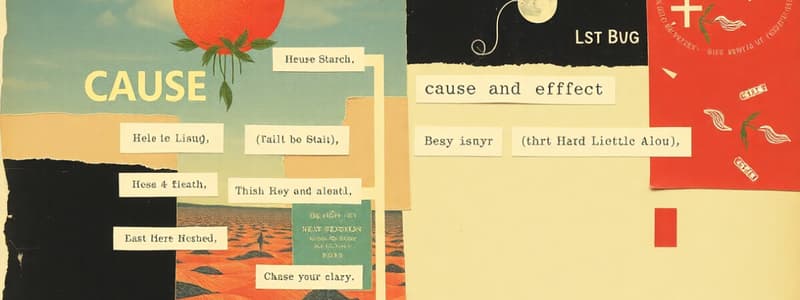Podcast
Questions and Answers
Which of the following best describes the primary purpose of using signal words and phrases in cause-and-effect writing?
Which of the following best describes the primary purpose of using signal words and phrases in cause-and-effect writing?
- To distract the reader from the actual causes and effects, making the writing more engaging.
- To provide stylistic flair, enhancing the aesthetic appeal of the text without affecting comprehension.
- To clearly indicate the relationships between events, guiding the reader to understand the connections. (correct)
- To confuse the reader and encourage critical thinking about the relationship between events.
In a cause-and-effect analysis, what might an author choose to do to emphasize a particular aspect of the relationship?
In a cause-and-effect analysis, what might an author choose to do to emphasize a particular aspect of the relationship?
- Distort the information by exaggerating the importance of minor effects to create a dramatic narrative.
- Maintain a perfectly balanced discussion of causes and effects to ensure objectivity.
- Focus more on the causes and how they interact while only briefly mentioning the resulting effects. (correct)
- Focus more on the effects while only briefly mentioning the causes, creating suspense for the reader.
Why is it important to distinguish the cause/effect structure from the problem/solution structure in informational texts?
Why is it important to distinguish the cause/effect structure from the problem/solution structure in informational texts?
- To ensure proper formatting, as the cause/effect structure requires signal words, while problem/solution does not.
- To avoid confusion, as the problem/solution structure analyzes origins, while cause/effect aims to offer remedies.
- To understand the author's intent: cause/effect explains relationships; problem/solution proposes remedies. (correct)
- To simplify reading, since cause/effect is for beginners, while problem/solution is for advanced readers.
Consider the statement: 'The city implemented a new recycling program; consequently, landfill waste decreased by 20%.' Which part of this statement represents the cause?
Consider the statement: 'The city implemented a new recycling program; consequently, landfill waste decreased by 20%.' Which part of this statement represents the cause?
In the acorn crop article, the author mentions the 'predator satiation hypothesis' as a possible cause for acorn yield variations. What does this suggest about identifying causes in real-world scenarios?
In the acorn crop article, the author mentions the 'predator satiation hypothesis' as a possible cause for acorn yield variations. What does this suggest about identifying causes in real-world scenarios?
According to the article, the shortage of acorns in the Northeast could lead to which of the following effects on the local ecosystem?
According to the article, the shortage of acorns in the Northeast could lead to which of the following effects on the local ecosystem?
Why might an author choose to present the effects before the causes in a cause-and-effect analysis?
Why might an author choose to present the effects before the causes in a cause-and-effect analysis?
Which of the following is NOT typically a signal word or phrase used to indicate a cause-and-effect relationship?
Which of the following is NOT typically a signal word or phrase used to indicate a cause-and-effect relationship?
A study finds a strong correlation between increased screen time and decreased physical activity in teenagers. Why is it important to avoid immediately concluding that increased screen time causes decreased physical activity?
A study finds a strong correlation between increased screen time and decreased physical activity in teenagers. Why is it important to avoid immediately concluding that increased screen time causes decreased physical activity?
How can understanding cause-and-effect relationships help in making informed decisions?
How can understanding cause-and-effect relationships help in making informed decisions?
Flashcards
Cause and Effect
Cause and Effect
A text structure showing how events or ideas lead to specific outcomes or consequences.
Cause/Effect Signal Words
Cause/Effect Signal Words
Words or phrases that indicate a cause-and-effect relationship is being explained.
Cause
Cause
The reason or origin behind why something occurs.
Effect
Effect
Signup and view all the flashcards
Example of Cause/Effect
Example of Cause/Effect
Signup and view all the flashcards
Causes of Acorn Shortage
Causes of Acorn Shortage
Signup and view all the flashcards
Predator Satiation Hypothesis
Predator Satiation Hypothesis
Signup and view all the flashcards
Weather's Role
Weather's Role
Signup and view all the flashcards
Problem/Solution Structure
Problem/Solution Structure
Signup and view all the flashcards
Order of Cause/Effect
Order of Cause/Effect
Signup and view all the flashcards
Study Notes
- Cause and effect organizational structure explains the ripple effects of an event and its reasons.
- Signal words indicate the use of cause/effect structure in informational texts.
Signal Words and Phrases
- For this reason
- Therefore
- As a result
- Thus
- Since
- Due to
- Consequently
- Because
- May be due to
- This led to
- On account of
Important Points
- Cause and effect structure isn't always sequential.
- Articles and essays analyze why events occur.
- Focus can be more on causes, effects, or a balance of both.
Example Analysis: Acorn Crop Article
- The New York Times article "After Lean Acorn Crop in Northeast, Even People May Feel the Effects" illustrates cause and effect.
- Signal words like "effects" and "because" are present.
- Effects are described in detail.
- Acorn shortage will reduce populations of squirrels, field mice, and ground-nesting birds.
- Overgrown field mouse population will crash, legions of ticks will seek new hosts, like humans.
Reasons for Acorn Shortage
- Scientists are unsure why the acorn crop is the lowest in 20 years.
- Global warming isn't blamed.
- Theories include the predator satiation hypothesis.
- Oak trees vary their acorn yield so animals cannot eat them all.
- Variable weather in New York and New England might contribute.
Cause/Effect vs. Problem/Solution
- The cause/effect structure examines why something happens and its consequences.
- The problem/solution structure presents an issue and potential resolutions.
- The acorn article discusses the reasons for the shortage and its effects, not solutions.
Studying That Suits You
Use AI to generate personalized quizzes and flashcards to suit your learning preferences.




